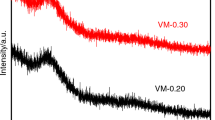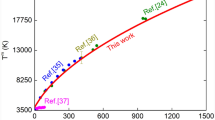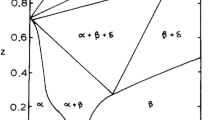Abstract
Reduction potentials (E 0) and diffusion rates (D) for divalent nickel in a variety of silicate melts and as a function of temperature have been measured in situ using voltammetric methods. These measurements provide an indirect window into structural changes in melts at temperatures above the liquidus. Slope of the reduction potential versus temperature (related to entropy) and slope of the diffusion rate versus 1/T (related to diffusional activation energy) remain roughly constant or change only gradually above the liquidus, with the exception of a sharp break in slope typically observed about 60–160°C above the liquidus. This sharp break is consistent with a structural transition in the melt rather than with a gradual change in melt structure. A correlation between the transition temperature and the liquidus temperature, combined with the qualitative effect of prior crystallization, suggests that the transition may be related to the melt “preparing” for crystallization roughly 100°C above the liquidus. These observations may have implications for understanding melt activities, partitioning between melt and crystalline phases, and liquid immiscibility.








Similar content being viewed by others
Notes
The focus of this study is on changes above the liquidus, and therefore possible formation of non-visible "microcrystals" below the liquidus temperature was not examined in detail. However, voltammetric scans made after the sample was cooled below the liquidus (but without visible crystallization) show no significant change from measurements made prior to cooling, arguing that microcrystals, even if present below the liquidus, do not affect our results. Also, no sharp change in either the diffusion rate or reduction potential was observed in crossing the liquidus temperature, and thus there is no reason to suspect micro-crystallization. In contrast, very obvious changes in electrochemical properties were observed in experiments with confirmed crystallization.
The absence of an observed slope shift in ggAl4-B and ggAl2-B may be a consequence of lower Al2O3 concentrations in those compositions. ggAl4-B and ggAl2-B have the lowest Al2O3 concentrations of the compositions studied, whereas the largest change in slope (e.g., change in B/nF) is observed in the highest-Al2O3 composition (P3AN1300), as seen in Table 3.
References
Aune RE, Hayashi M, Sridhar S (2005) Thermodynamic approach to physical properties of silicate melts. Ironmak Steelmak 32:141–150
Bard AJ, Faulkner LR (1980) Electrochemical methods. Wiley, New York, p 718
Bottinga Y, Richet P (1978) Thermodynamics of liquid silicates, a preliminary report, Earth Planet. Sci Lett 40:382–400
Bottinga Y, Weill DF (1972) The viscosity of magmatic silicate liquids: a model for calculation. Am J Sci 272:438–475
Bouhifd MA, Gruener G, Mysen BO, Richet P (2002) Premelting and calcium mobility in gehlenite (Ca2Al2SiO7). Phys Chem Miner 29:655–662
Brandriss ME, Stebbins JF (1988) Effects of temperature on the structures of silicate liquids: 29Si NMR results. Geochim Cosmochim Acta 52:2659–2670
Brooker RA, Kohn SC, Holloway JR, McMillan PF (2001) Structural controls on the solubility of CO2 in silicate melts. Part I. Bulk solubility data. Chem Geol 174:225–239
Burnham CW, Nekvasil H (1986) Equilibrium properties of granite pegmatite compositions. Am Min 71:239–263
Clark TM, Grandinetti PJ, Florian P, Stebbins JF (2004) Correlated structural distributions in silica glass. Phys Rev B 70:1–8
Colson RO, Haskin LA, Crane D (1990) Electrochemistry of cations in diopsidic melt: determining diffusion rates and redox potentials from voltammetric curves. Geochim Cosmochim Acta 54:3353–3367
Colson RO, Keedy CR, Haskin LA (1995) Diffusion and activity of NiO in CaO–MgO–Al2O3–SiO2 melts considering effects of aO2− and γNi2+. Geochim Cosmochim Acta 59:909–925
Colson RO, Floden AM, Hendrickson TR, Malum KM, Sawarynski M, Nermoe MKB, Jacobs KE, Holder D (2005) Activities of NiO, FeO, and O2 determining diffusion rates and redox in silicate melts. Geochim Cosmochim Acta 69:3061–3073
Cormier L, Calas G, Gaskell PH (2001a) Cationic environment in silicate glasses studied by neutron diffraction with isotopic substitution. Chem Geol 174:349–363
Cormier L, Galoisy L, Delaye J-M, Ghaleb D, Calas G (2001b) Short- and medium-range structural order around cations in glasses: a multidisciplinary approach. Compte Rendus de L’Academie des Sciences-Series IV-Physics 2:249–262
Cormier L, Ghaleb D, Neuville DR, Delaye J-M, Calas G (2003) Chemical dependence of network topology of calcium aluminosilicate glasses: a computer simulation study. J Non-Cryst Solids 332:255–270
Cormier L, Ferlat G, Itie J-P, Galoisy L, Calas G, Aquilanti G (2007) Amorphous–amorphous transformation at high pressure in gallo-germanosilicate tetrahedral network glasses. Phys Rev B 76:5
Courtial P, Téqui C, Richet P (2000) Thermodynamics of diopside, anorthite, pseudowollastonite, CaMgGeO4 olivine, and akermanite up to near the melting point. Phys Chem Min 27:242–250
Darken LS (1967) Thermodynamics of binary metallic solutions. Trans Metal Soc AIME 239:80–89
Doyle CD (1988) Prediction of the activity of FeO in multicomponent magma from known values in [SiO2–KAlO2–CaAl2Si2O8]–FeO liquids. Geochim Cosmochim Acta 52:1827–1834
George AM, Richet P, Stebbins JF (1998) Cation dynamics and premelting in lithium metasilicate (Li2SiO3) and sodium metasilicate (Na2SiO3): a high-temperature NMR study. Am Min 83:1277–1284
Ghiorso MS, Sack RO (1994) Chemical mass transfer in magmatic processes. IV. A revised and internally consistent thermodynamic model for the interpolation and extrapolation of liquid–solid equilibria in magmatic systems at elevated temperatures and pressure. Contrib Min Pet 119:197–212
Giordano D, Dingwell DB (2003) Non-Arrhenian multicomponent melt viscosity: a model. Earth Planet Sci Lett 6556:1–13
Hammer JE (2004) Crystal nucleation in hydrous rhyolite: experimental data applied to classical theory. Am Min 89:1673–1679
Hess PC (1971) Polymer model of silicate melts. Geochem Cosmochim Acta 35:289–306
Hess PC (1995) Thermodynamic mixing properties and the structure of silicate melts. In: Stebbins JF, McMillan PF, Dingwell DB (eds) Structure, dynamics and properties of silicate melts. Mineralogical Society of America, Washington, pp 145–189
Kirkpatrick RJ (1983) Theory of nucleation in silicate melts. Am Min 68:66–78
Lee SK, Stebbins JF (2003) Nature of cation mixing and ordering in Na–Ca silicate glasses and melts. J Phys Chem B 107:3141–3148
Lee SK, Fei Y, Cody GD, Mysen BO (2003) Structure and disorder of silicate melts at high pressure: 17O 3Q MAS NMR, quantum calculations and thermodynamics modeling. Geochim Cosmochim Acta 67:A248
Levin EM, Robbins CR, McMurdie HF (1969) Phase Diagrams for Ceramists 1969 Supplement, American Ceramic Society, Columbus OH USA. Fig. 2647, 625p
Lofgren GE (1983) Effect of heterogeneous nucleation on basaltic textures: a dynamic crystallization study. J Petrol 24:229–255
Massiot D, Fayon F, Montouillout V, Pellerin N, Hiet J, Roiland C, Florian P, Coutures J-P, Cormier L, Neuville DR (2007) Structure and dynamics of oxide melts and glasses: a view from multinuclear and high temperature NMR. J Non-Cryst Solids 354:249–254
McMillan PF, Wolf GH (1995) Vibrational spectroscopy of silicate liquids. In: Stebbins JF, McMillan PF, Dingwell DB (eds) Structure, dynamics and properties of silicate melts. Mineralogical Society of America, Washington, pp 247–315
Merzbacher CI, Sherriff BL, Hartman JS, White WB (1990) A high-resolution 29Si and 27Al NMR study of alkaline earth aluminosilicate glasses. J Non-Cryst Solids 124:194–206
Montel C, Russel C, Freude E (1988) Square-wave voltammetry as a method for the quantitative in situ determination of polyvalent elements in molten glass. Glastech Ber 61:59–63
Mysen BO, Richet P (2005) Developments in geochemistry 10: silicate glasses and melts properties and structure. Elsevier, NY, p 544
Mysen BO, Virgo D, Seifert F (1985) Relationships between properties and structure of aluminosilicate melts. Am Min 70:88–105
Mysen BO, Lucier A, Cody GD (2003) The structural behavior of Al3+ in peralkaline melts and glasses in the system Na2O–Al2O3–SiO2. Am Min 88:1668–1678
Navrotsky A (1995) Energetics of silicate melts. In: Stebbins JF, McMillan PF, Dingwell DB (eds) Structure, dynamics and properties of silicate melts. Mineralogical Society of America, Washington, pp 121–143
Navrotsky A, Geisinger KL, McMillan P, Gibbs GV (1985) The tetrahedral framework in glasses and melts: influences from molecular orbital calculations and implications for structure, thermodynamics, and physical properties. Phys Chem Min 11:284–298
Neuville DR (2005) Structure and properties in (Sr, Na) silicate glasses and melts. Phys Chem Glasses 46:112–118
Neuville DR, Mysen BO (1996) Role of aluminum in the silicate network: in situ, high-temperature study of glasses and melts on the join SiO2–NaAlO2. Geochim Cosmochim Acta 60:1727–1738
Neuville DR, Courtial P, Dingwell DB, Richet P (1993) Thermodynamic and rheological properties of rhyolite and andesite. Contrib Min Petrol 113:572–581
Neuville DR, Cormier L, Flank A-M, Briois V, Massiot D (2004) Al speciation and Ca environment in calcium aluminosilicate glasses and crystals by Al and Ca K-edge X-ray absorption spectroscopy. Chem Geol 213:153–163
Osborn EF, DeVries RC, Gee KH, Kraner HM (1954) Optimum composition of blast furnace slag as deduced from liquidus data for the quaternary system CaO–MgO–Al2O3–SiO2. Trans AIME 200:33–45
Osteryoung JG, Osteryoung RA (1985) Square-wave voltammetry. Anal Chem 57:101A–110A
Pelton AD, Wu P (1999) Thermodynamic modeling of glass-forming melts. J Non-Cryst Solids 253:178–191
Poole PH, Grande T, Angell CA, McMillan PF (1997) Polymorphic phase transitions in liquids and glasses. Science 275:322–323
Richet P, Ingren J, Mysen BO, Courtial PL, Gillet P (1994) Premelting effects in minerals: an experimental study. Earth Planet Sci Lett 121:589–600
Roberts CJ, Debenedetti PG (1996) Polyamorphism and density anomalies in network-forming fluids: zeroth- and first-order approximations. J Chem Phys 105:658–672
Sato RK, McMillan PF, Dennison P, Dupree R (1991) A structural investigation of high alumina glasses in the CaO–Al2O3–SiO2 system via Raman and magic angle spinning nuclear magnetic resonance spectroscopy. Phys Chem Glasses 32:149–160
Scamehorn CA, Angell CA (1991) Viscosity–temperature relations and structure in fully polymerized aluminosilicate melts from ion dynamics simulations. Geochim Cosmochim Acta 55:721–730
Seifert FA, Mysen BO, Virgo D (1982) Three-dimensional network structure in the systems SiO2–NaAlO2, SiO2–CaAl2O4 and SiO2–MgAl2O4. Am Min 67:696–711
Semkow KW, Rizzo RA, Haskin LA, Lindstrom DJ (1982) An electrochemical study of Ni2+, Co2+, and Zn2+ ions in melts of composition CaMgSi2O6. Geochim Cosmochim Acta 46:1879–1889
Tanaka H (1996) A self-consistent phase diagram for supercooled water. Nature 380:328–330
Toplis MJ (2001) Quantitative links between microscopic properties and viscosity of liquids in the system SiO2–Na2O. Chem Geol 174:321–331
Toplis MJ, Dingwell DB, Lenci T (1997) Peraluminous viscosity maxima in Na2O–Al2O3–SiO2 liquids: the role of triclusters in tectosilicate melts. Geochim Cosmochim Acta 61:2605–2612
Urbain G, Bottinga Y, Richet P (1982) Viscosity of liquid silica, silicates and alumino-silicates. Geochim Cosmochim Acta 46:1061–1072
Vetere F, Behrens H, Holtz F, Neuville DR (2006) Viscosity of andesitic melts: new experimental data and a revised calculation model. Chem Geol 228:233–245
Youngman RE, Haubrich ST, Zwanziger JW, Janicke MT, Chrnelka BF (1995) Short- and intermediate-range structural ordering in glassy boron oxide. Science 269:1416–1420
Zotov N, Delaplane R (1999) Structure and crystallization kinetics of sodium tetrasilicate glass: a high temperature neutron diffraction study. Mater Sci Forum 321–324:535–539
Acknowledgments
This work was supported in part by the NASA Grant NAG5-7366. Our thanks are due to P. Richet, J. K. Russell, B. Mysen, and an anonymous reviewer for comments and suggestions that led to improvements in this manuscript. We also thank Tim Grove for the editorial handling.
Author information
Authors and Affiliations
Corresponding author
Additional information
Communicated by T.L. Grove.
Rights and permissions
About this article
Cite this article
Colson, R.O. In situ voltammetric observation of transitions above the liquidus in silicate melts. Contrib Mineral Petrol 159, 703–717 (2010). https://doi.org/10.1007/s00410-009-0449-7
Received:
Accepted:
Published:
Issue Date:
DOI: https://doi.org/10.1007/s00410-009-0449-7




